Canopy walkway


Canopy walkways provide pedestrian access to the forest canopy. Early walkways consisted of bridges between trees in the canopy of a forest; mostly linked up with platforms inside or around the trees. They were originally intended as access to the upper regions of ancient forests for scientists conducting canopy research. Eventually, because they provided only limited, one-dimensional access to the trees, they were abandoned for canopy cranes. Today they serve as ecotourism attractions in places such as Dhlinza Forest, KwaZulu-Natal, South Africa, Taman Negara National Park, Malaysia, Sedim River, Kulim and Kakum National Park, Ghana.
The Kendeda Canopy Walk in Atlanta, Georgia is a more recent variation that provides visitors with the ability to move through a 180-metre-long (600 ft) section of urban forest at an elevation of 12 metres (40 ft). The walkway construction is a somewhat unusual reverse suspension design.
The first such canopy walkway constructed in Australia can be found in Lamington National Park at O'reilly's Rainforest, Queensland. Built in 1988 it is 180 metres (590 ft) in length and constructed using 9 small suspension bridges. At its highest point it reaches 34 metres (110 ft) above ground level. [1]
References